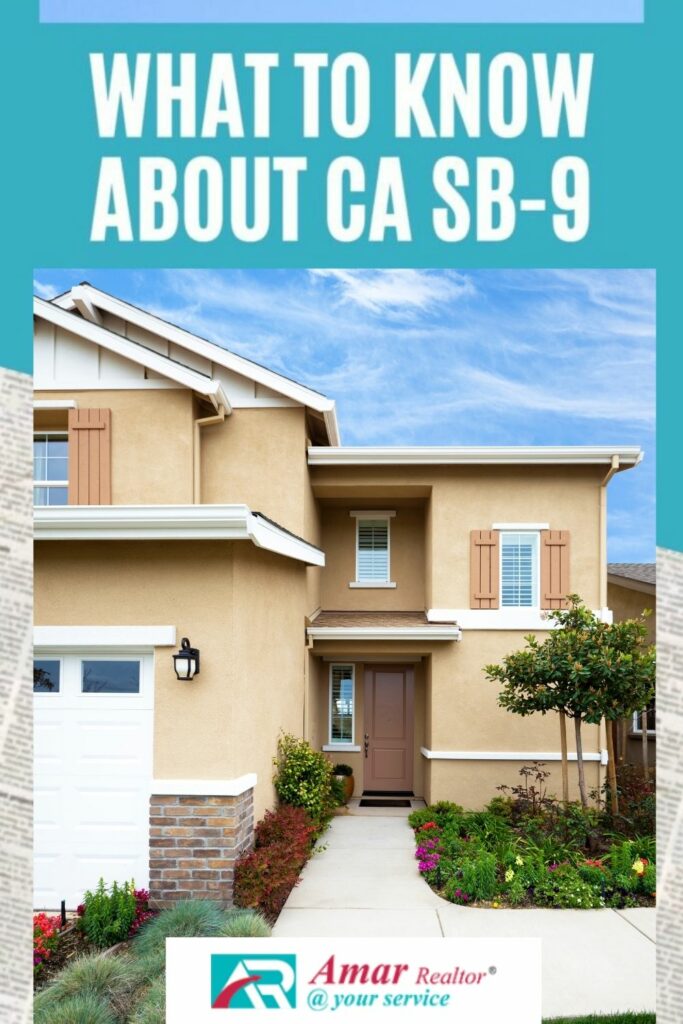What to Know about CA SB-9
If you are a homeowner in California or hope to become a homeowner soon, CA SB-9 may be relevant to you.
This law, also called the California Housing Opportunity and More Efficiency (HOME) Act, is important to understand if you own or plan to purchase a single-family home in California.
Keep reading for information on the law and how it may be relevant to you.
What is CA SB-9?
“SB 9, the California Housing Opportunity and More Efficiency (“HOME”) Act, facilitate the process for homeowners to subdivide their current residential lot or build a duplex. State law currently provides for the creation of accessory dwelling units by local ordinance or, if a local agency has not adopted a rule, by ministerial approval, by specified standards and conditions. SB 9 allows for pastoral support of duplex residential development on single-family zoned parcels without discretionary review or hearings.
SB 9 allows housing development projects of no more than two dwelling units on a single-family zoned parcel to be permitted on a ministerial basis if the project satisfies the SB 9 requirements. For a housing project to qualify under SB 9, the project must be located within a city, the boundaries of which must include some portion of either an urbanized area or urban cluster, as designated by the United States Census Bureau, or, for unincorporated areas, the parcel must be wholly within the boundaries of an urbanized area or urban cluster. The project may not require demolition or alteration of the following types of housing: (i) housing that is subject to a recorded covenant, ordinance, or law that restricts rents to affordable levels, (ii) housing subject to rent control, or (iii) housing that has been tenant-occupied in the last three (3) years (with no distinction drawn between market rate and affordable housing). Further, the project may not have been withdrawn from the rental market under the Ellis Act within the past fifteen (15) years. The proposed development also may not demolish more than twenty-five percent (25%) of existing exterior structural walls unless expressly permitted by a local ordinance or the project has not been tenant occupied within the past three years.
The project may not be located within a historic district or property included on the State Historic Resources Inventory or within a site designated as a city or county landmark or historic property under local ordinance. A local agency may impose objective zoning, subdivision, and design standards unless they preclude the two units from being at least 800 square feet in floor area.
No setback may be required for an existing structure or a structure constructed in the same location and dimensions as an existing structure. In other circumstances, a local agency may require a setback of up to four feet (4′) from the side and rear lot lines. Off-street parking of up to one (1) space per unit may be required by the local agency, except if the project is located within a half-mile walking distance of a high-quality transit corridor or a major transit stop or if there is a car share vehicle within one block of the parcel. Suppose a local agency makes a written finding that a project would create a specific, adverse impact on public health and safety or the environment without feasible mitigation. In that case, the agency may still deny the housing project.
A local agency must require that the rental of a unit created under SB 9 be for a term longer than 30 days, thus preventing the application of SB 9 to promote speculation in the short-term rental market.
Projects that meet the SB 9 requirements must be approved by a local agency ministerially and are not subject to the California Environmental Quality Act (“CEQA”).
SB 9 also allows qualifying lot splits to be approved ministerially upon meeting the bill requirements. Each parcel may not be smaller than forty (40%) percent of the original parcel size, and each lot must be at least one thousand two hundred (1,200) square feet in length unless permitted by local ordinance. The property must also be limited to residential use. Neither the property owner being subdivided nor any person acting in concert with the owner may have previously subdivided an adjacent property using a lot split as provided in SB 9. The applicant must also provide an affidavit that the applicant intends to use one of the housing units as a principal residence for at least three (3) years from the approval date.
A local agency may not condition its approval of a project under SB 9 upon a right-of-way dedication, any off-site improvements, or correction of nonconforming zoning conditions. The local agency is not required to approve more than two (2) units on a parcel. The local agency may require easements for public services and facilities and access to the public right-of-way.
SB 9 changes the rules regarding the life of subdivision maps by extending the additional expiration limit for a tentative map that may be provided by local ordinance, from 12 months to 24 months.” – Sourced from Gibsondunn.com.
 How This Bill Works
How This Bill Works
CA SB-9 is a bill that has been written as a way to combat the housing crisis in California. The bill streamlines the process for homeowners to split an existing lot or create a duplex in a zone previously limited to single-family homes. It is carefully designed to avoid the displacement of tenants or the destruction of the feel of a neighborhood.
When describing what CA SB-9 will do, legislators say the bill will “enable homeowners to create intergenerational wealth and provide access to more rental and ownership options for working families who would otherwise be priced out of neighborhoods.
It is important to note that CA SB-9 differs from recent legislation for Accessory Dwelling Units (ADUs). Under CA SB-9, a homeowner who occupies a single-family home in an area zoned for single-family dwellings exclusively will now be able to build or remodel to create a duplex on their property or to split the property into two lots and build a second single-family home.
What Does SB 9 Say?
SB 9 would allow for a maximum of four homes total or two homes per parcel if the lot were split. SB 9 is sometimes called the “duplex law,” and critics claim that entire neighborhoods of single-family homes could transition to duplexes. [Source]
 When Does the Law Go into Effect?
When Does the Law Go into Effect?
Starting January 1, 2022, CA SB-9 went into effect. After years of discussing it, you can finally benefit from this legislation.
How Will CA SB 9 Affect Property Values?
Time will tell how CA SB-9 will affect the property values of single-family homes. Some experts are concerned that single-family home values may decrease as neighborhoods change to include more duplexes and smaller lots. Other experts think the opportunity to own an income or divide your property to benefit family members will offset this potential loss in property value.
Whatever happens, experts predict that owning real estate in California will continue to be a good investment.
Who Benefits from CA SB-9?
CA SB-9 is specifically designed to benefit homeowners, not real estate developers. To help from CA SB-9, the property owner must occupy it. No tenants may be displaced when splitting the lot or building additional units.
The law is designed to give homeowners more freedom to build homes for multi-generational family members or to offer rental properties. People struggling to find affordable housing in California will benefit from CA SB-9, as well as those interested in dividing their property or constructing a duplex and previously thought they would be unable to because of zoning laws.
FAQs about CA SB 9
- Will apartment buildings be built in single-family neighborhoods? No, CA SB-9 only permits up to four units on a single-family home parcel, and the new units must be neighborhood-scale homes that keep with the community’s look.
- Does CA SB 9 apply to historic homes? No, CA SB-9 excludes historic homes and landmark districts.
- Will CA SB 9 lead to demolitions and evictions? The law is designed to protect tenants and promote lot splitting without destroying the existing home.
- How can I apply? Homeowners who wish to construct a multi-dwelling unit (including dividing an existing structure) or divide a lot will submit their application as usual to the city planning division. And CA SB-9 will inform the approval process.
To learn more details, let’s talk with Amar REALTOR®.
Let’s schedule a meeting with Amar REALTOR to review all your Real Estate objectives at a time that works for you.
 Please Click the link below to schedule a time on my online calendar!
Please Click the link below to schedule a time on my online calendar!
https://www.amarrealtor.com/meetingwithamarrealtor/
Contact Amar REALTOR® today for more information about Buying/Selling a Home in the Bay Area!
Amar REALTOR® offers expert real estate services with proven results in Bay Area Housing Market, including Homes for sale in Santa Clara County, San Mateo County, Contra Costa County, and Alameda County.
More Local Information:
– The San Francisco Bay Area Housing Report 2022
